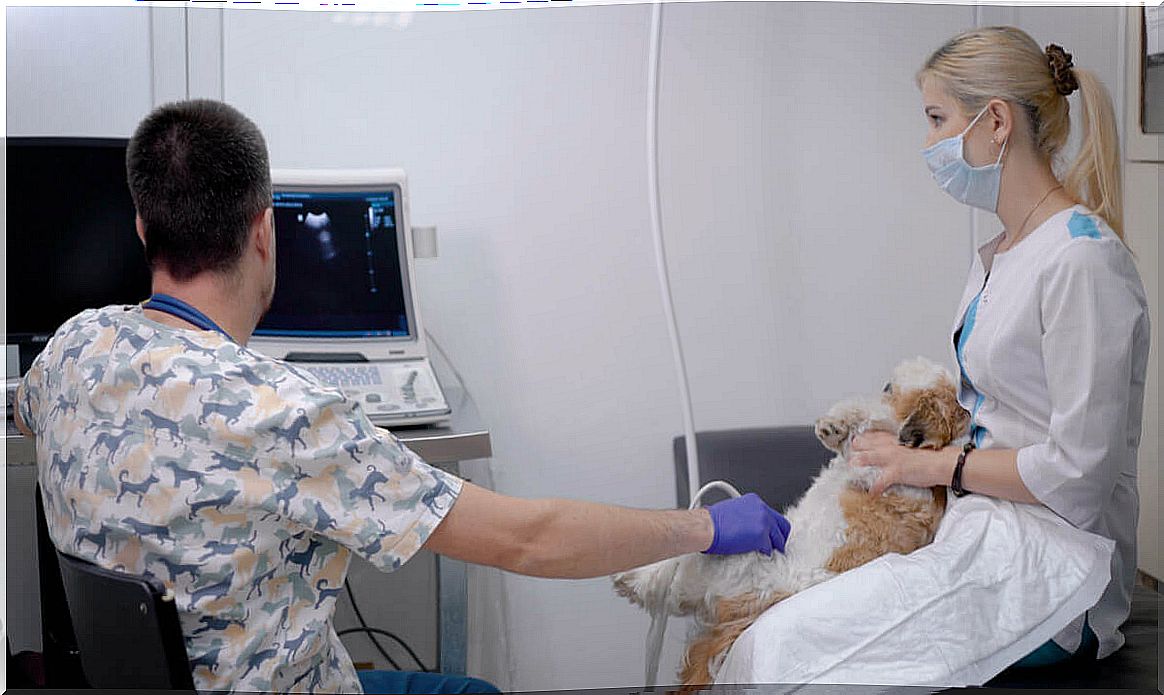Four Causes Of Abdominal Effusion In Pets

The abdominal cavity is located immediately below the chest, after the diaphragm, reaching the pelvis. It contains most of the viscera involved in digestion, in addition to the urinary and reproductive systems. In a healthy individual, there should be no fluid in this cavity. However, there are numerous causes for an abdominal effusion in animals.
This accumulation of fluid is nonspecifically called ascites. It is not detectable with the naked eye until the amount is so large that the abdomen starts to swell up. The fluid will put pressure on the abdominal viscera and vessels, but also the chest cavity. Therefore, it is a serious problem and must be correctly diagnosed to remedy it.
Causes of Abdominal Effusion in Pets
Next, we’ll talk about the four most common causes of abdominal stroke in pets.
haemoabdomen
As its name suggests, this term means “free blood in the abdomen”. Its causes are multiple and bleeding can come from different organs, the most frequent being the liver and spleen. Generally, they originate from:
- A trauma.
- Rupture of an intra-abdominal neoplasm (in dogs, hemangiosarcomas in the spleen are quite common).
- A coagulopathy. These pathologies are, unfortunately, quite typical, as they are caused by the consumption of rodenticides.
- A liver disease.

Peritonitis
Peritonitis, by definition, is inflammation of the serous membrane surrounding the abdomen. It can be septic (ie, with the presence of bacteria) or not. In the case of septic peritonitis, the abdominal fluid usually contains degenerated neutrophils.
The most common cause of septic peritonitis is rupture or perforation of the gastrointestinal tract. This causes intestinal bacteria to loosen in the abdomen, causing a serious infection.
Nonseptic peritonitis can be caused by inflammatory processes in the viscera, such as pancreatitis or hepatitis. In cats, feline infectious peritonitis (FIP) should always be considered as a possible cause of non-septic exudation.
A particular case: biliary peritonitis
This type of peritonitis occurs when the gallbladder ruptures and its contents are released into the abdominal cavity. The cause of the rupture can be trauma, neoplasm, gallstones, etc. Biliary peritonitis is usually aseptic. However, bile can contain bacteria if it comes from an infected gallbladder. This means that the exudate is septic and the prognosis is more reserved.
Uroabdomen or uroperitoneum
The uroabdomen is the result of a ruptured urinary tract, the most common being a ruptured bladder. As a result, urine accumulates in the abdominal cavity and causes peritonitis due to chemical irritation. It is one of the most frequent causes of abdominal effusion in multiple trauma patients.
Chlous ascites, another form of abdominal effusion in animals
It occurs due to the accumulation of “kilo” in the abdomen due to the rupture or obstruction of the abdominal lymph ducts. Unlike what happens in human medicine, this pathology is very rarely observed in dogs and cats.
Kilo is a fluid composed of bile, pancreatic juice and lipids, produced in the intestine during the digestion of fatty foods. It is taken up by lymphatic vessels and, if these rupture, ascites occurs.
Do all causes of abdominal effusion in animals originate in the digestive or urinary organs?
The answer is no. In fact, one of the most common sources of effusion in cavities, whether in the chest or abdomen, is the circulatory system. For example, right-sided heart failure causes blood to pool in the veins. This often causes swelling in the extremities and abdomen. That is, ascites occurs.

Therefore, we can observe that a problem that seemed to originate only from a digestive or urinary cause does not always occur that way. That is why it is so important to make a good diagnosis and to know the origin of the stroke. In this way, it is possible to treat the disease properly.








